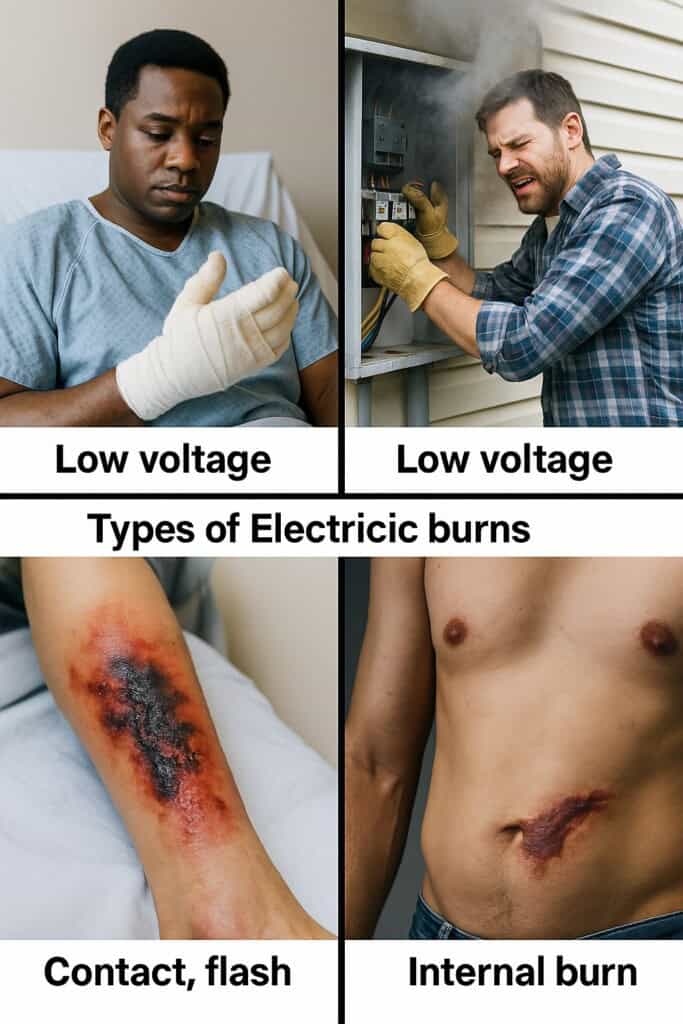Workplace accidents can happen in many forms, but few are as devastating and complex as electrical injuries. Employees who suffer from shocks or burns are often left with long-term medical complications and difficult questions about liability and compensation. Understanding the different types of electrical burns at the workplace is not only important for medical treatment but also critical for determining what legal options may be available to injured workers.
Electrical burns vary greatly in severity depending on voltage, the path of current through the body, and the type of contact involved. These differences matter because the extent of injury can directly influence the outcome of a workers’ compensation claim or a potential personal injury lawsuit.
How Voltage Impacts the Severity of Electrical Burns
One of the most important distinctions in electrical injury cases is whether the accident involved low voltage or high voltage exposure.
- Low-voltage injuries (under 500 volts):
While often perceived as “less dangerous,” low-voltage shocks can still cause serious harm. Even contact with standard office or household currents can lead to painful burns, muscle damage, or cardiac complications. From a legal perspective, these cases sometimes face challenges because insurance carriers may downplay the severity of the injury. Victims must often rely on medical records and expert testimony to demonstrate the long-term effects of a seemingly minor burn. - High-voltage injuries (above 500 volts):
High-voltage incidents are much more likely to result in catastrophic damage, including deep tissue burns, amputations, and even death. In workplace settings such as construction, manufacturing, or utility maintenance, these injuries may involve multiple liable parties — employers, subcontractors, or equipment manufacturers. Because of the extreme medical costs and lifelong impairments associated with high-voltage burns, these cases typically involve significant legal claims for compensation.
Types of Electrical Burns Commonly Seen at Work
Electrical injuries are not all the same. The medical community generally recognizes several categories, and each carries different implications for both treatment and legal recovery. The different types of electrical burns at the workplace include:
- Contact burns: Occur when a worker touches an energized wire or piece of equipment directly. These can leave severe entry and exit wounds, making it easier to prove the connection between the accident and the injury.
- Flash burns: Result from an electrical arc that produces intense heat without current passing through the body. Legally, these cases may require evidence of faulty equipment, poor maintenance, or lack of protective gear.
- Arc burns (arc flash injuries): Involve both heat and high-intensity light, often damaging skin and eyes simultaneously. These incidents often occur in industrial environments where safety regulations are critical, making OSHA violations a potential factor in a claim.
- Thermal burns: Sometimes secondary to electrical exposure, these burns happen when clothing ignites or nearby equipment overheats. Liability can expand to include employers who failed to provide flame-resistant uniforms or protective barriers.
- Internal burns: Perhaps the most dangerous, these are caused when current travels through the body, damaging muscles, blood vessels, and organs. Because internal burns may not be visible, legal claims often hinge on advanced diagnostic tests and expert evaluations to establish the true extent of harm.
Long-Term Consequences for Victims
Unlike surface-level injuries such as cuts or bruises, electrical burns can create hidden complications. Victims may suffer from nerve damage, heart rhythm disturbances, chronic pain, or psychological trauma.
From a legal standpoint, this long-term impact is critical. Compensation is not just about covering emergency room bills; it should also account for:
- Reconstructive surgeries or skin grafts
- Physical rehabilitation
- Psychological counseling for post-traumatic stress
- Lost wages and reduced earning capacity
- Permanent disability or disfigurement
Establishing these future needs requires careful documentation, which experienced personal injury attorneys can help gather.
Workplace Safety Standards and Employer Liability
Employers have a legal duty to maintain a safe workplace. OSHA and state regulations mandate that electrical systems be inspected, protective gear provided, and employees trained in hazard awareness. When these standards are ignored, the risk of electrical burns increases dramatically.
For instance, failure to de-energize circuits during maintenance, lack of lockout/tagout procedures, or poor insulation on machinery may directly expose workers to danger. If an employer disregards these obligations, legal liability may extend beyond workers’ compensation, potentially allowing victims to pursue negligence claims.
Proving Fault in Electrical Burn Cases
Determining responsibility after an electrical accident is rarely straightforward. Several parties might be at fault:
- Employers who fail to enforce safety protocols.
- Contractors who create unsafe conditions on job sites.
- Manufacturers of defective equipment.
- Property owners who neglect wiring and facility maintenance.
To succeed in a claim, injured workers often need to establish how the accident occurred, which type of burn they suffered, and whether safety rules were violated. Eyewitness testimony, incident reports, maintenance logs, and medical evaluations all become essential evidence.
The Legal Value of Electrical Burn Cases
Not all electrical burn claims are valued equally. The nature of the burn plays a central role. A superficial flash burn may support a smaller claim limited to medical costs and lost wages, while deep internal burns that cause permanent disability can justify substantial compensation for lifelong care.
Attorneys often work with medical specialists to illustrate how voltage, current path, and tissue damage correspond to long-term impairment. By aligning medical evidence with legal arguments, they build a case that reflects the true impact on a victim’s life.
What Victims Should Do After an Electrical Burn
Anyone injured in a workplace electrical accident should take immediate steps to protect both their health and their legal rights:
- Seek emergency medical care, even if the burn appears minor.
- Report the incident to supervisors and ensure an official record is created.
- Preserve any evidence — damaged tools, protective gear, or photographs of the accident site.
- Follow through with medical evaluations to document internal injuries.
- Consult with a personal injury attorney to explore whether workers’ compensation is sufficient or if a third-party claim is warranted.
Final Thoughts
Electrical accidents at work are among the most complex personal injury cases because the type of burn, the voltage involved, and the resulting complications all influence medical outcomes and legal claims. By understanding the different types of electrical burns at the workplace, employees and their families can better navigate both recovery and the pursuit of fair compensation.
For victims, the key takeaway is clear: never underestimate the seriousness of electrical burns, and never assume that insurance companies or employers will fully account for long-term damage. Speaking with a knowledgeable attorney ensures that your rights are protected and that you receive the support you need to move forward after such a life-changing injury.


